Welcome new readers of RMP’s quarterly H2 infrastructure report. Each quarter we look back on the major stories related to hydrogen infrastructure advancements and we compare the current AFDC database to the AFDC database in the prior quarter to see what has changed. The AFDC database is updated by the US Dept of Energy & can be found by clicking here. Canada added a new data repository for hydrogen stations in Q2-2020. The Canadian website is administered by Natural Resources Canada. RMP will continue to use the US Department of Energy database as our primary data source as we learn more about the new Canadian database. All this data (and more) goes into RMP’s interactive map of hydrogen infrastructure in the USA & Canada you can see by clicking here. Ok, on with the report…
The big news this quarter is California Energy Commission’s GFO-19-602 Hydrogen Refueling Infrastructure draft solicitation being awarded September 4, 2020 for $115.7M & the matching contributions from applicants of an additional $201.7M. $5M of the total award will come from the
Volkswagen Environmental Mitigation Trust Funds and go exclusively to True Zero with the highest NOPA score at 98.2%. That’s a whopping total of $317.5 million appropriated for 123 next gen H2 refueling stations in California! Can I just say “wow” before writing the next sentence? That’s a lot of money & stations. And, things are different this time around, all 123 stations are next generation stations that can fill 3 to 5 times more vehicles than current stations according to the language in the bid instructions.
Every applicant was required to have 3 years of experience designing, planning, constructing, testing, operating, or maintaining hydrogen refueling stations or other pressurized gaseous fueling stations. This means the funds are ready to go and every applicant awarded is experienced at building new stations. That means these stations should be able to come online with dependable project timelines in the march toward 100 stations in California. In fact, it was an award requirement for the stations to be able to get permitted & built in 18 months and then be open to the public with 12 months of that as next rounds of funding begin.
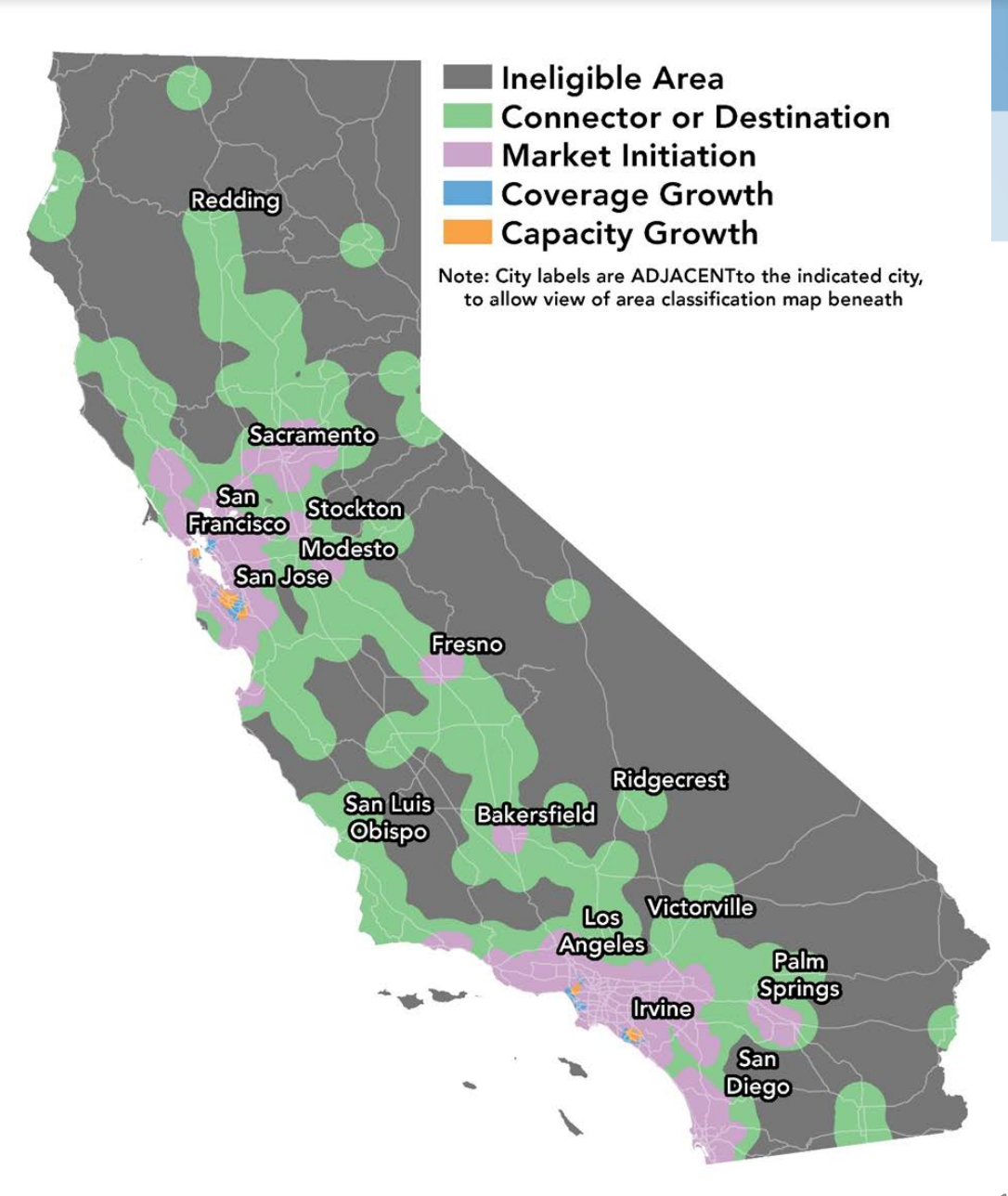
That these stations can come online expeditiously is great, but what really makes this news a double whammy are the next generation station refueling capabilities. The original “demonstation” stations that have been operating in California since RMP started publishing this infrastructure report in December 2017 were meant to show the general public that hydrogen fuel cells work as advertised. The stations awarded in CEC’s GFO-19-602 are next generation stations. These stations are no longer to prove the technology works, these stations are to demonstrate how well hydrogen can scale. We will likely see the number of FCEVs on the road in California (approx 7.5k FCEVs) double & triple with the next round of “big” stations. This simple math will resonate with the public to send this message: as fast as you build the stations, FCEVs can scale. You can never run out of hydrogen, it’s cost only goes down as you make more, and hydrogen refueling stations put zero pressure on the grid. Hydrogen fuel cells are a zero emissions solution that compliments BEVs to really start to take a significant percentage of fossil fuel cars off the road.
Let’s Look at the Station Requirements:
Each station in a “connector” location can have up to but not more than two fueling positions & each station in a Market Initiation, Coverage Growth, or Capacity Growth Area must have a minimum of two fueling positions. Each fueling position needed to meet the following criteria to be eligible for an award:
- Minimum 24-hour capacity of 225 kilograms
- 95 percent state of charge
- H70-T40 fills
What is a fueling position you might ask?
Fueling position refers to a unique physical location in which an FCEV can fuel from a hose simultaneously with other vehicles fueling from other hoses or dispensers. A fueling position shall not be shared with another dispenser of any fuel type, such that an FCEV would have to wait to fuel if the other dispenser’s fueling position were occupied.
With these 36 new stations ready to go and an option for the CEC to fund 28 more stations on this same funding round, the world will witness zero emission transportation start to scale in California. Unlike other zero emission transportation solutions, hydrogen’s ability to scale is not limited by expensive grid upgrades because hydrogen does not rely on the grid. Hydrogen can be made off site & delivered as an energy dense liquid. Each hydrogen liquefaction investment can serve multiple stations at high volume.
Each fueling position at this next round of stations must be capable of providing a minimum of seven 4-kilogram H70-T40 fills in one hour at 95 percent state of charge. A tranche refers to an entire collection of hydrogen refueling stations proposed by an Applicant. A batch refers to a subset of stations within a tranche for which a recipient will receive funding and work to complete. The initial batch of stations refers to the first set of stations that an Applicant proposes to deliver. Subsequent batches of stations may be approved, provided funding is available and other conditions are met, at the CEC’s discretion.
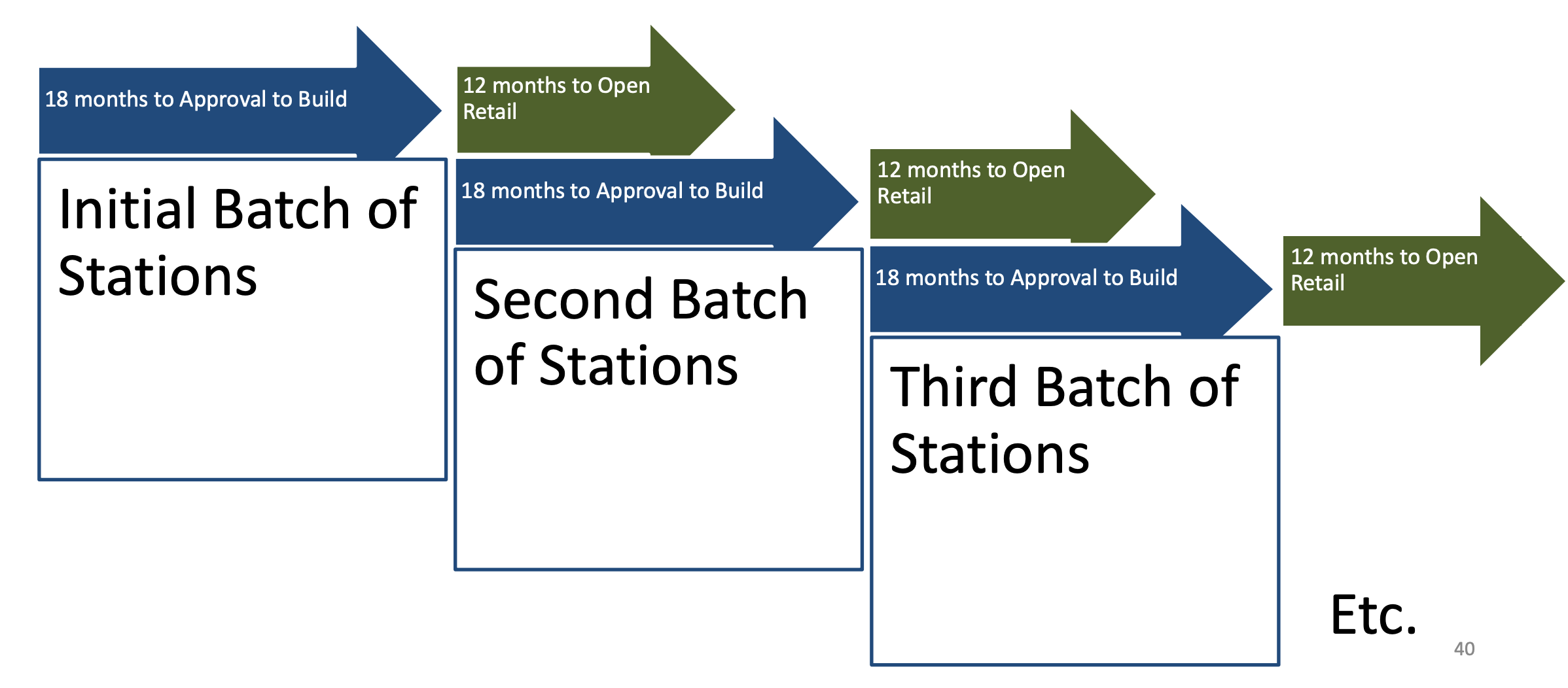
From the date the CEC approves the station under the agreement, the station should have approval to build from the authority having jurisdiction within 18 months. Also from the CEC approval date, the station must be open retail within 30 months. RMP believes this can go much quicker now in California for certain stations and therefore some of these stations will come online sooner than the max requirements. California benefits from having experienced government officials that have already gone through the safety protocols of permitting a hydrogen station. As soon as the government officials have ok’d the engineering plans, siting and construction will go faster than pioneer stations.
Stations funded under this solicitation must dispense renewable hydrogen to comply with the renewable hydrogen requirements of the CARB LCFS regulation for generating Hydrogen Refueling Infrastructure (HRI) credits. This is currently, based on company-wide, weighted average: – Carbon Intensity of 150 gCO2e/MJ or less – Renewable content of 40 percent or greater.
Let’s look at the Players:
The #1 winner of GFO-19-602 is First Element (dba True Zero) with a tranche of 49 stations awarded & 21 of those funded in the initial batch of stations funded by the CEC. The #2 winner was Equilon Enterprises LLC (hereafter Shell) with a 51 station tranche and an initial batch of 8 stations. Coming in#3 is Iwatani Corporation of America with a tranche of 23 stations & 7 of those as an initial batch funded by the CEC. Not making the cut this time were Toyota Tsusho America, SunLine Transit Agency, United Hydrogen Fuels, Air Products, and Stratos Fuel. All combined those companies that didn’t make the cut were asking for $64M and were willing to match $86M. That’s another $150M on the sidelines that is ready to get into the hydrogen infrastructure game that just missed the cut but will maybe be there for the next GFO. As a long time advocate for clean energy, this is a real milestone that moves California closer than anywhere else in the world to self-sustaining hydrogen stations opened by sole proprietors. Because of hydrogen’s limitless abundance everywhere, costs will only go down infrastructure scales up to meet hungry energy demand. The build out and creation of the hydrogen stations will create high tech jobs in construction, service, manufacturing, and distribution as well as ancillary jobs & indirect jobs.
Below is a table RMP compiled from the NOPA data from the CEC website. The top table shows the three total tranches funded & the Applicant’s matching funds. RMP has also calculated the totals & average project allocations based on simple math (i.e. total dollars / total stations). The next table shows the stations funded in the initial batch which will most likely be in the application permit phase soon.
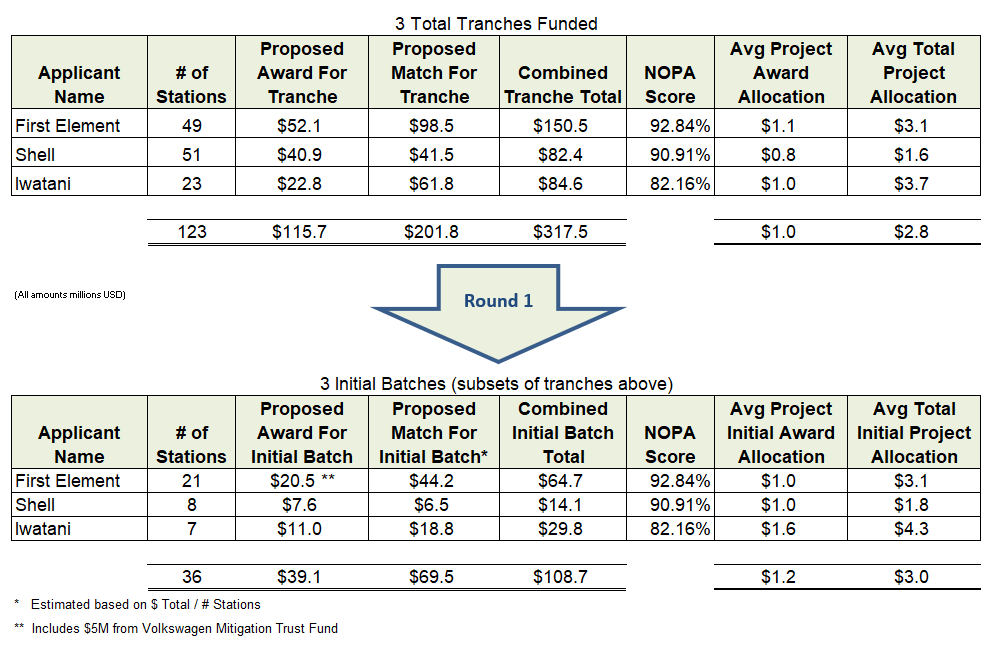
The next table shows the remaining stations & dollars for subsequent rounds of funding from the CEC’s Notice of Proposed Awards related to GFO-19-602 (i.e. Table 1 less Table 2).

35 of the 36 stations listed in the initial batch of funded stations showed a street address. RMP converted those addresses to latitudes & longitudes and was able to create a special map of all the new station locations you can open in a new page by clicking here. This new map allows you to see only the new stations. You can also view RMP’s regular map of ALL hydrogen refueling infrastructure by clicking here. Both maps now include the “hydrogen corridors” from the FHWA Office of Natural Environment, Sustainable Transport and Resilience Team. The hydrogen corridors across the USA are designated areas to locate retail hydrogen refueling structure across our country. You can read more about the hydrogen corridors by clicking here.
The United States government also announced some significant investments in hydrogen technology this past quarter with a funding opportunity announcement. Toward the end of July the US Dept of Energy’s Energy Efficiency & Renewable Energy Office’s (EERE’s) Hydrogen & Fuel Cell Technologies Office announced the notice of intent to fund $64 million in H2@Scale projects. H2@Scale supports innovations to produce, store, transport, and utilize hydrogen across multiple sectors, covering collaborations between various industry stakeholders and national laboratories. The initial H2@Scale FOA, released by EERE in FY19, focused on enabling R&D for hydrogen production, transport, and storage, as well as first-of-kind pilot demonstrations of integrated systems with on-site nuclear power and multiple renewable energy sources. The keys to continued advancement of H2@Scale are scaling up affordable hydrogen production and developing new uses for hydrogen, to grow the overall market size and develop technology that integrates hydrogen into the energy system. RMP compiled the table below of some $58M worth of projects the US DOE intends to fund in the latest round offered in July 2020. You can click the image to enlarge on a desktop computer if the text is too small to read.
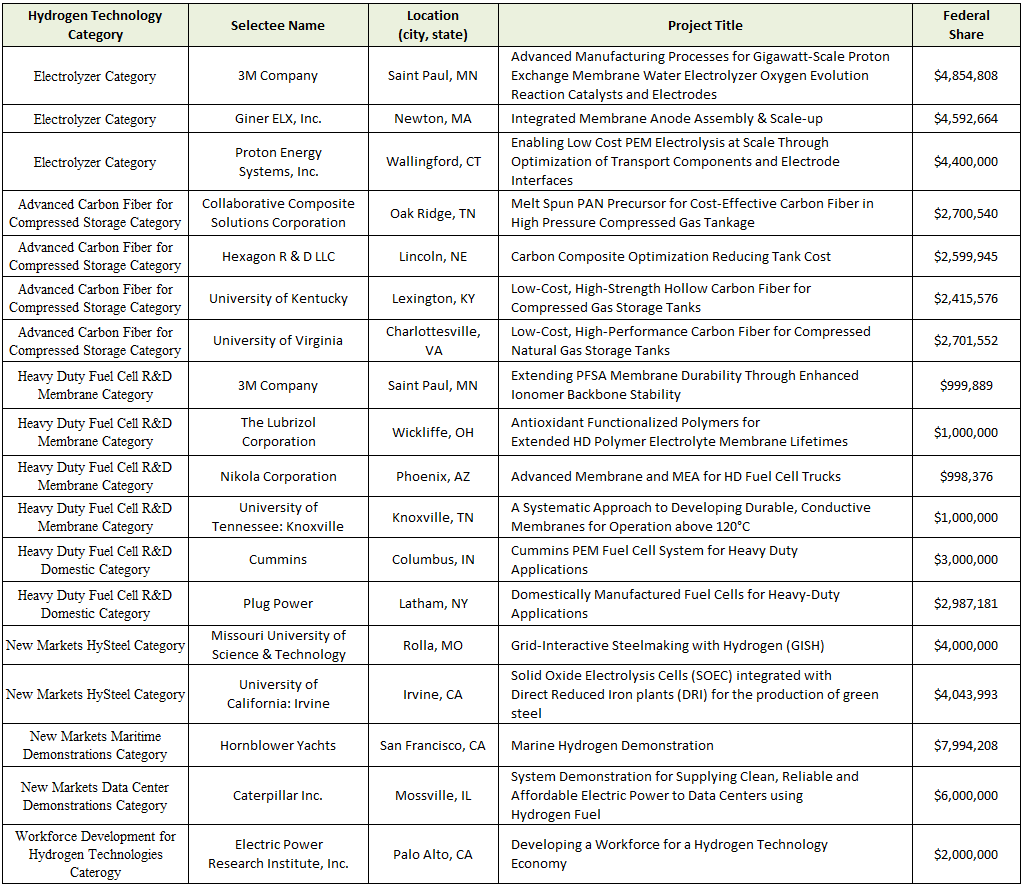
New H2 Stations That Opened To The Public 2020 Q3:
The Fountain Valley station opened to the California public on July 7th, 2020. The Fountain Valley station is a “next generation” station that has 1,200kg of capacity & receives delivered liquid hydrogen. Fountain Valley is in Southern California south of Los Angeles about half way between Newport Beach & Laguna Beach. This station has four fueling positions that can all operate simultaneously providing H70 fills. Next generation stations will allow the numbers of FCEVs on the road to increase significantly. Below is a photo of the Fountain Valley station from the CAFCP website where you can see what four fueling positions looks like.
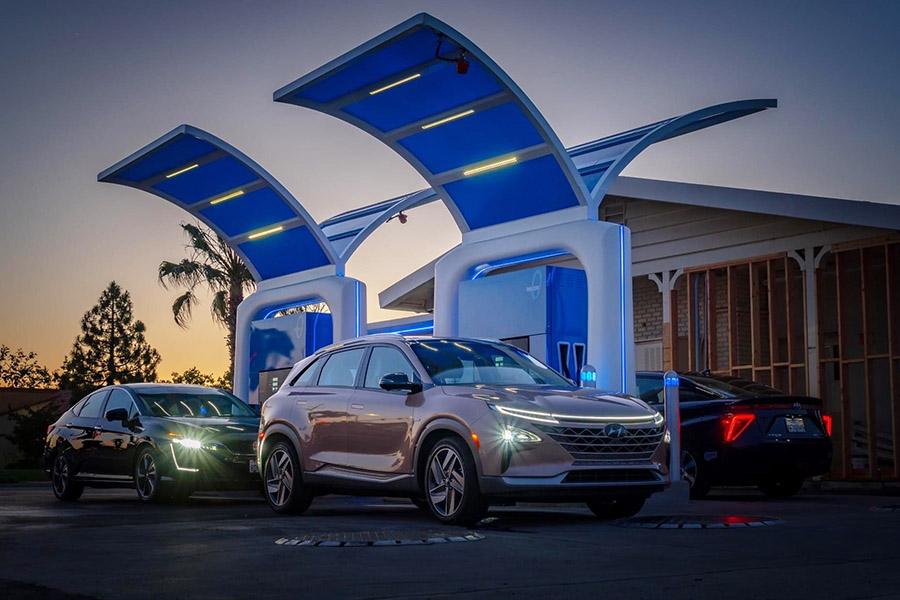
Fuel Cell Electric Vehicles On the Road 2020 Q3:
Each quarter, RMP updates the number of FCEVs on the road in the USA based on data from IHS Markit. IHS Markit is the standard data source in the auto industry to assess the number of vehicles on the road based on registration data. IHS Markit data lags by about 6 to 8 weeks, so June 30, 2020 data is the latest data available at September 30, 2020. Below is a table that shows the number of FCEV’s registered in the USA sorted by state largest to smallest.
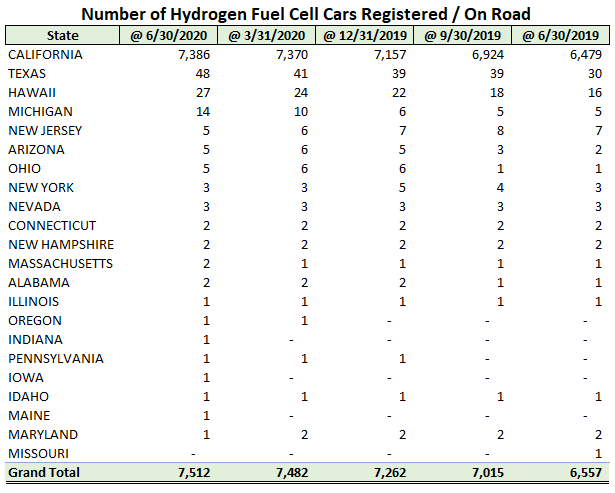
Other H2 Headlines from 2020 Q3:
9/19/2020 – An interesting recent story from the CBC talks about Canadian Hydrogen Strategy coupled with nuclear if they want to hit climate goals they agreed to in the Paris Climate Accord. Click Here To Read More.
7/28/2020 – Microsoft makes hydrogen fuel cell breakthrough using fuel cells to power data center in Utah for 48 hours. Pics of a fuel cell system & of three tube trailers outside. Part of Microsoft’s vision to be carbon negative is to use fuel cells for data centers & long-haul shipping. Click Here To Read More
7/27/2020 – Similar article to Microsoft story above but with more details. Click Here To Read More.
9/29/2020 – Just making the cut for this quarter’s report (and with a hat tip to RMP’s friend Matthew Klippenstein) we learned of three new stations planned in Washington state. A bulletin & infographic from Matthew announces the planned H2 stations for Washington state with the first being sited in Douglas County. RMP looks forward to plotting these stations on our map when we get coordinates. With stations in Vancouver & California, both Washington & Oregon can connect FCEV mobility from Canada to Mexico with less than a dozen hydrogen refueling stations.

Final Remarks for 2020 Q3:
As a self-confessed data junkie, this was an amazing quarter for data aggregation: 123 new stations to plot, over 11,000 miles of highway designated as “Hydrogen Corridors” with accompanying GIS data, NOPA spreadsheets from California with dollar figures to crunch, and more…wow… my urge to nerd out is satiated. What California is doing is truly world class leadership on the energy front. It’s more than just the act of leading into uncharted territory, it’s establishing a blue print for followers like Michigan. California’s economy is so much larger than Michigan’s which is RMP’s home state. It takes strong leadership to break the mould on the status quo and set examples for followers to follow. Speaking of strong, I gotta go back to Arnold Schwarzenegger and that crazy recall election in 2003 that was kind of the genesis for where we are today. Arnold was strong enough to win Mr. Olympia titles from 1970 to 1975 and was strong enough to push for the first “hydrogen highway” concept when he became governor. Arnold took a lot of heat when he pushed for change but had the strength to keep his resolve.

Growing up in my house in the late 1970’s & early 1980’s Arnold was a staple in my daily life as my older brother read all of Arnold’s books & told me all of his eating habits to get the right fuel for your body (this was well before X-boxes; when we used to read). Arnold knew that if you want to be strong, you have to have the right fuel in your body. The California Hydrogen Highway Network (CaH2Net) was initiated in April 2004 by Executive Order (EO) S-07-04 under Governor Arnold Schwarzenegger with the purpose of promoting hydrogen refueling stations in California; the right fuel for the road.
Just like you have to put the right fuel in your body to be strong, it was Arnold’s vision to put the right fuel on the road that led to California’s SB 1505 being signed into law in 2006. As a Michigan citizen all my life, I understand that Michigan is usually about 15 to 20 years behind the times compared to economies like California’s. RMP can be hopeful that eventually Michigan lawmakers will understand if you want to build a strong energy economy, you must have the right fuel, and Michigan can one day follow in California’s footsteps & establish our very first public hydrogen refueling station. Hydrogen is the right fuel for a sustainable economy and the right fuel for a strong economy. Congrats to all California citizens that participate as leaders in the energy transition to clean air & clean water & good paying jobs. One day the Hydrogen Highway concept kicked off with an executive order in 2004 in California will pass through Michigan. 2020-Q3 will be remembered as a milestone quarter on this long journey that will see over 100 hydrogen fueling stations open in California. Thanks for reading & see you next quarter.

Leave a Reply